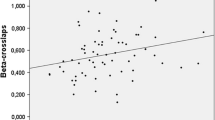Abstract
This study has been carried out in order to elucidate the clinical significance of serum osteocalcin measurement. The changes of this marker paralleled those of serum total alkaline phosphatase activity (a marker of bone formation) following parathyroidectomy in hyperparathyroid patients with skeletal involvement. Furthermore, the percentage decrease of serum osteocalcin levels in respect to basal values (85±12), and the percentage decrease of serum alkaline phosphatase activity levels (82±7) were significantly lower (p<0.001) in respect to that of the 24-h hydroxyproline/creatinine ratio (42±14) one week after parathyroid surgery. Instead, changes of serum osteocalcin levels were similar to those of serum free hydroxyproline (considered to be a marker of bone resorption) following acute calcitonin infusion in normal subjects. These results imply that the antibody used in our assay might recognize not only the entire osteocalcin molecule, but also small epitopes released during the process of bone matrix resorption. Alternatively, if we consider serum osteocalcin only as a marker related to some processes of bone formation, the experiment carried out on normal subjects strongly supports the evidence of calcitonin receptors in osteoblastic surfaces.
Similar content being viewed by others
References
Price P.A., Williamson M.K., Lothringer J.W. Origin of the vitamin K-dependent protein found in plasma and its clearance by kidney and bone. J. Biol. Chem. 256: 12760, 1981.
Minisola S., Scarnecchia L., Scarda A., Bigi F., Tabolli S., Valtorta C, Mazzuoli G.F. Serum osteocalcin in primary hyperparathyroidism: short-term effect of surgery. Mineral Electrolyte Metab. 14: 201, 1988.
Minisola S., Antonelli R., Mazzuoli G.F. Clinical significance of free plasma hydroxyproline measurement in metabolic bone disease. J. Clin. Chem. Clin. Biochem. 23: 515, 1985.
Price P.A., Nishimoto S.K. Radioimmunoassay for the vitamin K-dependent protein of bone and its discovery in plasma. Proc. Natl. Acad. Sci. USA. 77: 2234, 1980.
Scarnecchia L., Minisola S., Pacitti M.T., Carnevale V., Romagnoli E., Rosso R., Mazzuoli G.F. Clinical usefulness of serum tartrate-resistant acid phosphatase activity determination to evaluate bone turnover. Scand. J. Clin. Lab. Invest. 51: 517, 1991.
Gundberg C.M., Weinstein R. Multiple immunoreactive forms of osteocalcin in uremic serum. J. Clin. Invest. 77: 1762, 1986.
Taylor A.K., Linkhart S., Mohan S., Christenson R.A., Singer F.R., Baylink D.J. Multiple osteocalcin fragments in human urine and serum as detected by a midmolecule osteocalcin radioimmunoassay. J. Clin. Endocrinol. Metab. 70: 467, 1990.
Morel G., Boivin G., David L., Dubois P.M., Meunier P.J. Immunocytochemical evidence for endogenous calcitonin and parathyroid hormone in osteoblasts from the calvaria of neonatal mice. Cell Tissue Res. 240: 89, 1985.
Farley J.R., Wergedal J.E., Hall S.L., Herring S., Tarbaux N.M. Calcitonin has direct effects on 3(H)-thymidine incorporation and alkaline phosphatase activity in human osteoblast line cells. Calcif. Tissue Int. 48: 297, 1991.
Farley J.R., Hall S.L., Tarbaux N.M. Calcitonin (but non calcitonin gene-related peptide) increases mouse bone cell proliferation in a dose-dependent manner, and increases mouse bone formation, alone and in combination with fluoride. Calcif. Tissue Int. 45: 214, 1989.
Author information
Authors and Affiliations
Rights and permissions
About this article
Cite this article
Minisola, S., Carnevale, V., Pacitti, M.T. et al. Serum osteocalcin in metabolic bone diseases: What is its real significance?. J Endocrinol Invest 16, 277–279 (1993). https://doi.org/10.1007/BF03348831
Received:
Accepted:
Published:
Issue Date:
DOI: https://doi.org/10.1007/BF03348831




